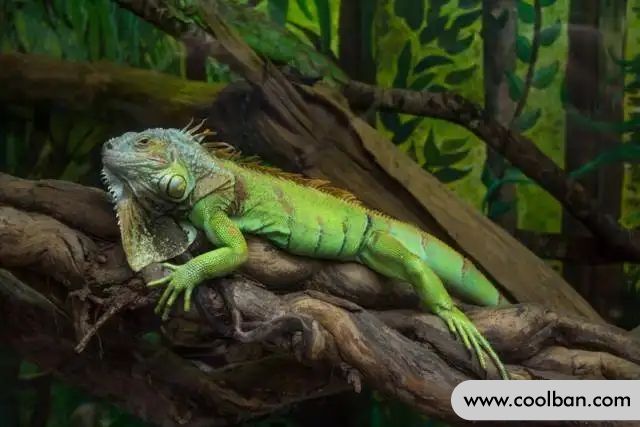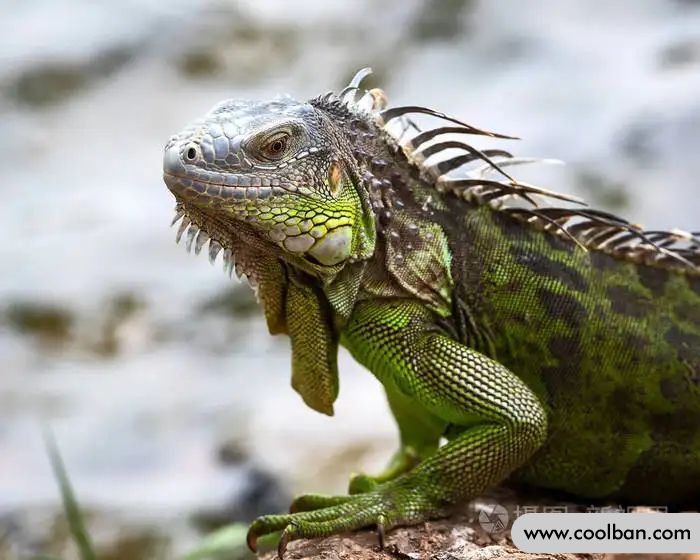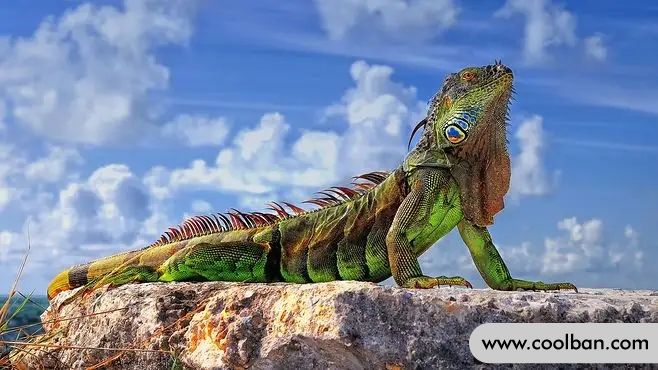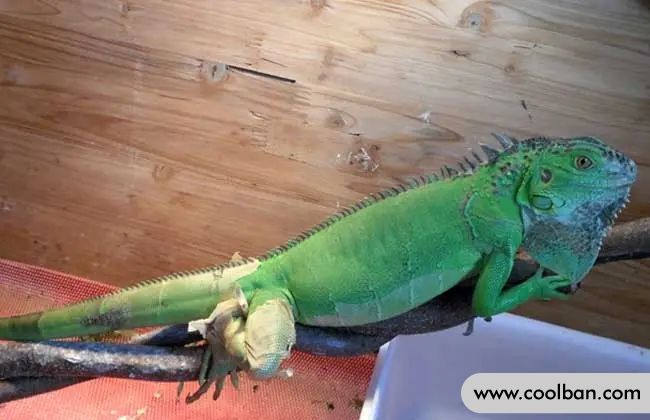What to prepare for raising green iguanas
2022-05-12
The green iguana is a typical arboreal lizard and has been one of the most popular pets in the United States. Green iguanas can grow up to two meters in length and weigh about eight kilograms in adulthood. Green iguanas also come in different colors at different ages.
Juvenile green iguanas usually have a green body that they use to avoid the sight of predators; as they age, the green color fades and is replaced by a pale yellow, pale blue, or brown, etc. The main physical features of green iguanas are comb-like scales on the back, black rings on the tail, and a large, drooping body. Adult male throat fan. In the wild environment, the lifespan of green iguanas is generally between 10-15 years, and some individuals will be longer; the lifespan of green iguanas in captivity can reach more than 20 years.

Green iguana living environment
Green iguanas are heat- and cold-resistant reptiles. As adults, green iguanas grow quickly and are large, and families need to have enough space to raise them. The layout of the living environment for raising green iguanas is particularly important.
Usually most people use a fish tank as a green iguana terrarium because it is the easiest to buy and obtain. Iron cages can also be used as breeding boxes, or wood and glass windows can be used as breeding boxes. If the fish tank is used directly, the ventilation will be poor. The use of iron cages is not conducive to thermal insulation.
1. Breeding box size
If you have enough space, you should provide a glass container as large as possible. Green iguanas are arboreal animals and spend most of their time in trees in the wild. When they are young, they are relatively active on the ground, so as they grow, they will climb more and more. Therefore, the rearing box should be made higher, not longer. The following are the minimum dimensions of the enclosure: height equal to body length (including tail), length 1.5 times body length, and width 2/3 body length. This allows the iguana to crawl and turn around more freely. If the space is too small, the iguana will become lethargic.

2. Ventilation
Ventilation issues are often overlooked. If it is a cage made of barbed wire, ventilation is of course not a problem. Even a glass tank with a glass lid will do, but not a fish tank with a completely sealed top. If you want to use a cylinder, it is best to use a cylinder with ventilation holes on the side, which will have good ventilation.
3. Humidity
The green iguana is a species of lizard that lives in the hot and humid regions of Central and South America. Higher humidity is good for the skin of green iguanas, but maintaining high humidity in the rearing environment is very difficult, not only because of the complicated equipment to maintain high humidity, but also difficult to maintain hygiene in such a high temperature and high humidity environment. Because food and feces tend to breed bacteria under the action of high temperature and high humidity.
Humidity maintenance: You can place a water basin in the breeding box, or use a humidifier, etc.

4. Temperature
The dry point during the day is 32~35 degrees Celsius, 32 degrees is more suitable, and the maximum temperature does not exceed 35 degrees. The temperature in the rest of the box is around 28 degrees. 25-28 degrees Celsius at night, the highest is not more than 30 degrees; humidity: 60%~80% above.
5. Climbing
Provide branches in the box for the iguana to climb on, preferably a little thicker than the iguana's body, and arrange the branches diagonally inside the box.

6. Lamps (UVA heating lamps, UVB lamps, night lamps or ceramic lamps)
Heating and Lighting (UVA Heat Lamps): Many people address heating and lighting at the same time. Incandescent lamps can be used for heating and lighting. Placing the light in one corner of the box creates an environment with a temperature gradient in the box. Directly under the lights is equivalent to a sunbathing spot, allowing the iguanas to warm up here in the morning. It is best to place thermometers in different places in the rearing box so that you can grasp the temperature of the entire box. Generally, the coldest place in the box is also around 80 degrees Fahrenheit. In general, green iguanas need an internal temperature of at least 88 degrees Fahrenheit each day for proper digestive function. It is best not to put the light directly into the box, as green iguanas can easily climb on the light and cause burns. Green iguanas rely on bacteria in their bodies to digest food, and bacteria need a relatively high temperature environment to function, so ensure enough temperature, otherwise green iguanas will suffer from malnutrition due to indigestion.
UVB light (ultraviolet light): It is very important to expose the iguana to UV light. They need to synthesize vitamin D3 in the skin by irradiating ultraviolet light, and D3 facilitates the absorption of calcium. Sunlight is the best option, if you can't get it, you have to prepare UV lamps (especially UVB lamps) for them. Be careful not to shine UV light on your iguana through glass or plexiglass, as these will attenuate the UV light drastically and a thin layer of glass can be removed 95% UV. You should not look at UV lamps with your eyes, because too strong UV rays are harmful to people.
Use UVB lamps during the day for 6-8 hours a day. UVB can be selected from 5.0 and 10.0.

Night light: The night light is like moonlight, the light is soft and weak, does not affect sleep, and is suitable for overnight feeding environment. Provides essential heat for reptile survival and digestion, so it can be used to heat green iguanas at night.
Ceramic lamp: Ceramic lamp does not emit light but only generates heat. It can also be used for heating at night, but because ceramic lamp will reduce the humidity of the breeding environment, pay attention to ensuring the humidity.
The "photocycle" photoperiod simply refers to how long each day the green iguana needs to be illuminated. It is generally recommended that the green iguana be exposed to light and UV light on a daily basis 14 Hour. However, it must be ensured that there is no light at night, if the lights are on for a long time, the green iguana will be nervous.
Floor mat: The principle of mat material selection is to facilitate cleaning and drying. Many people like to use newspapers as bedding because they can be thrown away after use. In short, don't use wood chips, sand, etc. that green iguanas easily swallow.
Cushion reference: floor leather + PVC tarpaulin; tiles are laid in reverse
Juvenile green iguanas usually have a green body that they use to avoid the sight of predators; as they age, the green color fades and is replaced by a pale yellow, pale blue, or brown, etc. The main physical features of green iguanas are comb-like scales on the back, black rings on the tail, and a large, drooping body. Adult male throat fan. In the wild environment, the lifespan of green iguanas is generally between 10-15 years, and some individuals will be longer; the lifespan of green iguanas in captivity can reach more than 20 years.

Green iguana living environment
Green iguanas are heat- and cold-resistant reptiles. As adults, green iguanas grow quickly and are large, and families need to have enough space to raise them. The layout of the living environment for raising green iguanas is particularly important.
Usually most people use a fish tank as a green iguana terrarium because it is the easiest to buy and obtain. Iron cages can also be used as breeding boxes, or wood and glass windows can be used as breeding boxes. If the fish tank is used directly, the ventilation will be poor. The use of iron cages is not conducive to thermal insulation.
1. Breeding box size
If you have enough space, you should provide a glass container as large as possible. Green iguanas are arboreal animals and spend most of their time in trees in the wild. When they are young, they are relatively active on the ground, so as they grow, they will climb more and more. Therefore, the rearing box should be made higher, not longer. The following are the minimum dimensions of the enclosure: height equal to body length (including tail), length 1.5 times body length, and width 2/3 body length. This allows the iguana to crawl and turn around more freely. If the space is too small, the iguana will become lethargic.

2. Ventilation
Ventilation issues are often overlooked. If it is a cage made of barbed wire, ventilation is of course not a problem. Even a glass tank with a glass lid will do, but not a fish tank with a completely sealed top. If you want to use a cylinder, it is best to use a cylinder with ventilation holes on the side, which will have good ventilation.
3. Humidity
The green iguana is a species of lizard that lives in the hot and humid regions of Central and South America. Higher humidity is good for the skin of green iguanas, but maintaining high humidity in the rearing environment is very difficult, not only because of the complicated equipment to maintain high humidity, but also difficult to maintain hygiene in such a high temperature and high humidity environment. Because food and feces tend to breed bacteria under the action of high temperature and high humidity.
Humidity maintenance: You can place a water basin in the breeding box, or use a humidifier, etc.

4. Temperature
The dry point during the day is 32~35 degrees Celsius, 32 degrees is more suitable, and the maximum temperature does not exceed 35 degrees. The temperature in the rest of the box is around 28 degrees. 25-28 degrees Celsius at night, the highest is not more than 30 degrees; humidity: 60%~80% above.
5. Climbing
Provide branches in the box for the iguana to climb on, preferably a little thicker than the iguana's body, and arrange the branches diagonally inside the box.

6. Lamps (UVA heating lamps, UVB lamps, night lamps or ceramic lamps)
Heating and Lighting (UVA Heat Lamps): Many people address heating and lighting at the same time. Incandescent lamps can be used for heating and lighting. Placing the light in one corner of the box creates an environment with a temperature gradient in the box. Directly under the lights is equivalent to a sunbathing spot, allowing the iguanas to warm up here in the morning. It is best to place thermometers in different places in the rearing box so that you can grasp the temperature of the entire box. Generally, the coldest place in the box is also around 80 degrees Fahrenheit. In general, green iguanas need an internal temperature of at least 88 degrees Fahrenheit each day for proper digestive function. It is best not to put the light directly into the box, as green iguanas can easily climb on the light and cause burns. Green iguanas rely on bacteria in their bodies to digest food, and bacteria need a relatively high temperature environment to function, so ensure enough temperature, otherwise green iguanas will suffer from malnutrition due to indigestion.
UVB light (ultraviolet light): It is very important to expose the iguana to UV light. They need to synthesize vitamin D3 in the skin by irradiating ultraviolet light, and D3 facilitates the absorption of calcium. Sunlight is the best option, if you can't get it, you have to prepare UV lamps (especially UVB lamps) for them. Be careful not to shine UV light on your iguana through glass or plexiglass, as these will attenuate the UV light drastically and a thin layer of glass can be removed 95% UV. You should not look at UV lamps with your eyes, because too strong UV rays are harmful to people.
Use UVB lamps during the day for 6-8 hours a day. UVB can be selected from 5.0 and 10.0.

Night light: The night light is like moonlight, the light is soft and weak, does not affect sleep, and is suitable for overnight feeding environment. Provides essential heat for reptile survival and digestion, so it can be used to heat green iguanas at night.
Ceramic lamp: Ceramic lamp does not emit light but only generates heat. It can also be used for heating at night, but because ceramic lamp will reduce the humidity of the breeding environment, pay attention to ensuring the humidity.
The "photocycle" photoperiod simply refers to how long each day the green iguana needs to be illuminated. It is generally recommended that the green iguana be exposed to light and UV light on a daily basis 14 Hour. However, it must be ensured that there is no light at night, if the lights are on for a long time, the green iguana will be nervous.
Floor mat: The principle of mat material selection is to facilitate cleaning and drying. Many people like to use newspapers as bedding because they can be thrown away after use. In short, don't use wood chips, sand, etc. that green iguanas easily swallow.
Cushion reference: floor leather + PVC tarpaulin; tiles are laid in reverse
